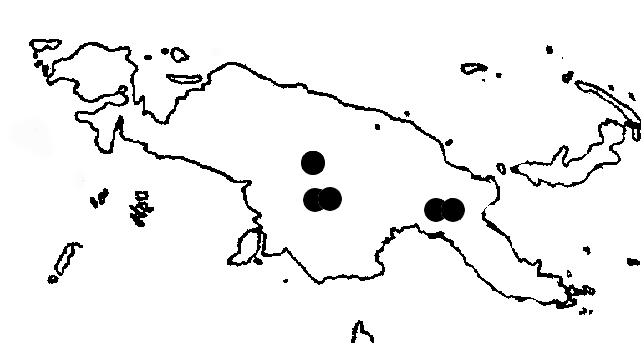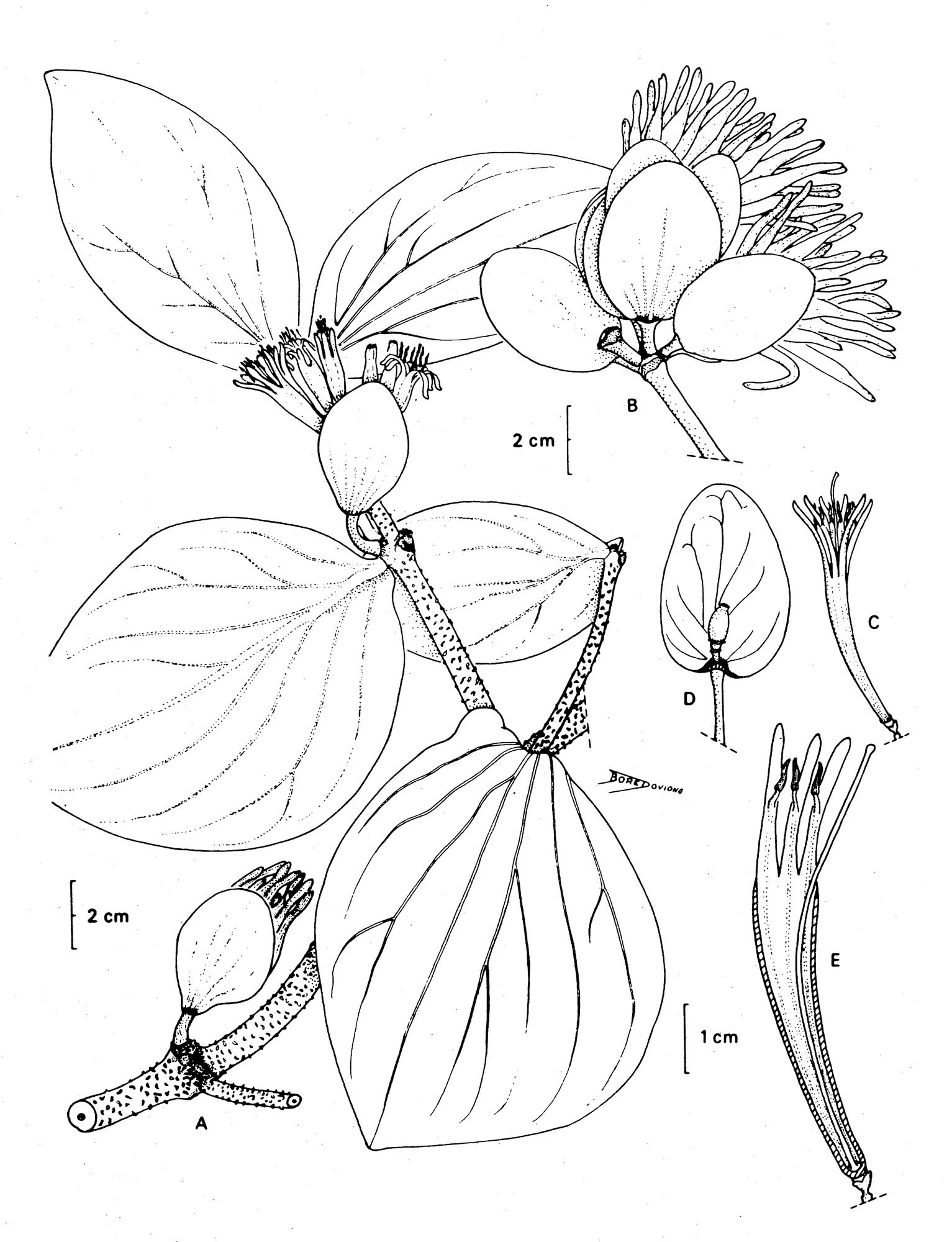
Distribution Map

Description (Barlow 1974)
Papuanthes albertisii (Tiegh.) Dans. Bull. Jard. bot. Buitenz. 11: 360, illus. Fig. 15 (1931); Diplatia albertisii Tiegh. Bull. Soc. bot. Fr. 41: 539 (1894); Dans. Bull. Jard. bot. Buitenz. 10: 312 (1929); Loranthus albertisii (Tiegh.) Engl. Pfl. Fam.Nachtr. 129 (1897). Type-New Guinea, Fly R., d'Albertis sn., 1877 (P, holotype, not seen; FI, photo in AD).
Glabrous. Stems terete, enlarged at the nodes, distinctly lenticellate, much branched. Leaves opposite, usually with a seemingly superposed arrangement through the extreme contraction of every second internode and the reduction of every second pair of leaves to scales; sessile or rarely with a terete petiole a few mm long; lamina ovate, 8-20 by 5-12 cm, rather thickly coriaceous, dull on both sides, truncate rounded or rarely slightly cordate at the base, obtuse at the apex; venation pennate with the midrib and the lateral veins visible on both sides. Inflorescence a head of (8)-12-(15) flowers arranged in two rows on the flattened apex of a stout peduncle 6 mm long and 35 mm wide; involucral bracts ovate to orbicular, 25-40 by 20-25 mm, connate at the margins in the lower third, obtuse or rounded at the apex; flowers on pedicels 1.5-2 mm long which are articulate above the middle and with a bract at the apex and rarely a bract below the articulation; these bracts acute, c. 1.5 mm long. Calyx campanulate to funnel-shaped, 3-4 mm long; limb entire. Corolla in the mature bud 40-65 mm long; petals in the open flower 6, gamopetalous to above the middle. Anthers c. 3 mm long, equal to the free parts of the filaments. Fruit urceolate, up to 15 mm long; fruiting pedicels greatly enlarged and thickened. (Fig. 7, f-h.) Chromosome Number.-n = 9 (new record). Voucher: Henty and Barlow NGF 42973, see below.
Occurrence. New Guinea (Fig. 8); upper reaches of the Fly R. and its tributaries, 20 to 800 in altitude, and also Menyamya Subdistrict, 1360 in altitude.
Specimens Examined. WE5T IRIAN: Okwalimkan R. headwaters, 1200 m alt., Ridsdale, Henty and Galore NGF 31994, 17.vi.1967 (LAE). EASTERN NEW GUINEA: Ok Tedi R., c. 2 miles above d'Albertis Junction, C. 20 malt., Henty and Barlow NGF 49122, 49123, 31.viii.1970 (AD; LAE); Fly R., c. 4 miles above Kiunga, c. 20 m alt., Henty and Barlow NGF 42973, 29.viii.1970 (AD; LAE); Aiewa, road to Aseki, Menyamya Subdist., 1360 m alt., Streimann and Kairo NGF 39028, 18.v.1968 (LAE); near Haumnga, Aseki Patrol Area, Morobe, 1550 m alt., Craven and Schodde 1105, 30.iii.1966 (CANB).
In the single specimen examined cytologically, the plant was heterozygous for a reciprocal translocation, and a metaphase association of one quadrivalent and seven bivalents was regular. The chromosomes are large, like those of most members of the Amyema group of genera.
Small irregularities were seen at the apex
of the pedicel in many cases; these have been interpreted and
described as bracteoles by Danser (1931).
Illustrations

Papuanthes albertsii. A. flowering twig. B - inflorescences. C - flower. D - flower with front section cut away. E - fruit and bract, after front bract was removed. From Barlow (1981).
|
|
|
| Papuanthes albertsii. A - inflorescence, of which one of the involucral bracts and one of the rows of flowers is taken away. B -pedicel with bract and bracteoles. From Danser (1931). |
Papuanthes albertsii. A. flower. B - portion of plant. C - portion of inflorescence with one bract removed. From Barlow (1974). |
Photographs

Ok Tedi, 2 miles above d'Albertis junction, Kiunga Subdistrict, Western District, Papua New Guinea. Coll. by E. E. Henty and B. Barlow (NGF 49123), 31 Aug. 1970. Photo by Dan Nickrent.

Near Haumga, Aseki Patrol Area, Morobe District, Papua New Guinea. Coll. L. A. Craven and R. Schodde (no. 1105). 30 March 1966. Photo by Dan Nickrent.

Same as above, close-up of bracteate inflorescences. Photo by Dan Nickrent.
Papuanthes albertisii
updated 20 January 2007